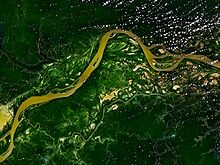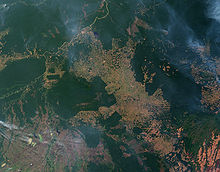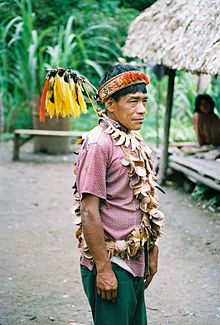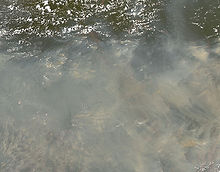- Deforestation of the Amazon Rainforest
-
Timelapse of deforestation in the state of Rondonia in Brazil, from 2000-2010.

 The Amazon River flowing through the rainforest.
The Amazon River flowing through the rainforest.
The main sources of deforestation in the Amazon Rainforest are human settlement and development of the land.[1] Between 1991 and 2000, the total area of Amazon Rainforest cleared for ranching and roads rose from 415,000 to 587,000 km²; a total area of more than six times that of Portugal, 64 percent larger than Germany, 55 percent larger than Japan, 21 percent larger than Sichuan or equal to 84 percent the area of Texas. Most of this lost forest has been replaced with pasture for cattle.[2] In February 2008, the Brazilian government announced that the rate at which the Amazon rainforest was being destroyed had been accelerating noticeably during the time of the year that it normally slows: In just the last five months of 2007, more than 3,200 sq. kilometers, an area equivalent to the state of Rhode Island, was deforested.[3]
Contents
History
Prior to the 1970's, access to the forest's interior was highly restricted, and aside from partial clearing along rivers the forest remained basically intact.[4] Deforestation accelerated greatly following the opening of highways deep into the forest, such as the Trans-Amazonian highway in 1972.
In many parts of Amazon, the poor soil had made plantation-based agriculture unprofitable. The key turning point in deforestation of the Brazilian Amazon was when colonists began to establish farms within the forest during the 1960s. Their farming system was based on crop cultivation and the slash and burn method. However, the colonists were unable to successfully manage their fields and the crops due to the loss of soil fertility and weed invasion.[5] In indigenous areas of the Peruvian Amazon, such as the Urarina's Chambira River Basin,[6] the soils are productive for relatively short period of time, and indigenous horticulturalists like the Urarina are therefore constantly moving to new areas and clearing more and more land.[5] Amazonian colonization was ruled by cattle raising because ranching required little labor, generated decent profits, and awarded social status in the community. Additionally, grass can grow in the poor Amazon soil. However, the results of the farming lead to extensive deforestation and caused extensive environmental damage.[7] An estimated 30% of the deforestation is due to small farmers and the intensity within the area that they inhabit is greater than the area occupied by the medium and large ranchers who possess 89% of the Legal Amazon’s private land. This emphasizes the importance of using previously cleared land for agricultural use, rather the typical easiest political path of distributing still-forested areas.[8] In the Brazilian Amazon, the amount of small farmers versus large landholders changes frequently with economic and demographic pressures.[8]
In 2008, Peruvian President Alan García pushed through by executive decree Law 840[9] (also known as "Ley de la Selva," "the Law of the Jungle" or simply the "Forest Law"), which allowed the sale of uncultivated Amazon land under state ownership to private companies, without term limits on the property rights.[10] While the law was promoted as a "reforestation" measure, critics claimed the privatization measure would in fact encourage further deforestation of the Amazon,[11] while surrendering the nation's rights over natural resources to foreign investors and leaving uncertain the fate of Peru's indigenous people, who do not typically hold formal title to the forestlands on which they subsist.[9][12] Law 840 met widespread resistance and was eventually repealed by Peru's legislature for being unconstitutional.[9]
Causes
 Fires and deforestation in Rondônia
Fires and deforestation in Rondônia
The Amazon Rainforest is being cut away for many different reasons. Cattle Pasture, the valuable hardwood, housing space and farming space especially soybeans are just the main reasons.The annual rate of deforestation in the Amazon region has continued to increase from 1990 to 2003 because of factors at local, national, and international levels.[4] 70% of formerly forested land in the Amazon, and 91% of land deforested since 1970, is used for livestock pasture.[13][14] In addition, Brazil is currently the second-largest global producer of soybeans after the United States, mostly for export and biodiesel production,[15] and as prices for soybeans rise, the soy farmers are pushing northwards into forested areas of the Amazon. As stated in Brazilian legislation, clearing land for crops or fields is considered an ‘effective use’ of land and is the beginning towards land ownership.[4] Cleared property is also valued 5–10 times more than forested land and for that reason valuable to the owner whose ultimate objective is resale. The needs of soy farmers have been used to validate many of the controversial transportation projects that are currently developing in the Amazon.[4] The first two highways: the Belém-Brasília (1958) and the Cuiaba-Porto Velho (1968) were the only federal highways in the Legal Amazon to be paved and passable year-round before the late 1990s. These two highways are said to be “at the heart of the ‘arc of deforestation’”, which at present is the focal point area of deforestation in the Brazilian Amazon. The Belém-Brasilia highway attracted nearly two million settlers in the first twenty years. The success of the Belém-Brasilia highway in opening up the forest was reenacted as paved roads continued to be developed unleashing the irrepressible spread of settlement. The completions of the roads were followed by a wave of resettlement and the settlers had a significant effect on the forest.[16]
Scientists using NASA satellite data have found that clearing for mechanized cropland has recently become a significant force in Brazilian Amazon deforestation. This change in land use may alter the region's climate. Researchers found that in 2003, the then peak year of deforestation, more than 20 percent of the Mato Grosso state’s forests were converted to cropland. This finding suggests that the recent cropland expansion in the region is contributing to further deforestation. In 2005, soybean prices fell by more than 25 percent and some areas of Mato Grosso showed a decrease in large deforestation events, although the central agricultural zone continued to clear forests. However, deforestation rates could return to the high levels seen in 2003 as soybean and other crop prices begin to rebound in international markets. This new driver of forest loss suggests that the rise and fall of prices for other crops, beef, and timber may also have a significant impact on future land use in the region, according to the study. [2]
In 1996, the Amazon was reported to have shown a 34% increase in deforestation since 1992.[17] The mean annual deforestation rate from 2000 to 2005 (22,392 km² per year) was 18% higher than in the previous five years (19,018 km² per year).[18] In Brazil, the Instituto Nacional de Pesquisas Espaciais (INPE, or National Institute of Space Research) produces deforestation figures annually. Their deforestation estimates are derived from 100 to 220 images taken during the dry season in the Amazon by the Landsat satellite, also may only consider the loss of the Amazon rainforest biome – not the loss of natural fields or savannah within the rainforest. According to INPE, the original Amazon rainforest biome in Brazil of 4,100,000 km² was reduced to 3,403,000 km² by 2005 – representing a loss of 17.1%.[19]
Period[20] Estimated remaining forest cover
in the Brazilian Amazon (km²)Annual forest
loss (km²)Percent of 1970
cover remainingTotal forest loss
since 1970 (km²)Pre–1970 4,100,000 — — — 1977 3,955,870 21,130 96.5% 144,130 1978–1987 3,744,570 21,130 91.3% 355,430 1988 3,723,520 21,050 90.8% 376,480 1989 3,705,750 17,770 90.4% 394,250 1990 3,692,020 13,730 90.0% 407,980 1991 3,680,990 11,030 89.8% 419,010 1992 3,667,204 13,786 89.4% 432,796 1993 3,652,308 14,896 89.1% 447,692 1994 3,637,412 14,896 88.7% 462,588 1995 3,608,353 29,059 88.0% 491,647 1996 3,590,192 18,161 87.6% 509,808 1997 3,576,965 13,227 87.2% 523,035 1998 3,559,582 17,383 86.8% 540,418 1999 3,542,323 17,259 86.4% 557,677 2000 3,524,097 18,226 86.0% 575,903 2001 3,505,932 18,165 85.5% 594,068 2002 3,484,538 21,394 85.0% 615,462 2003 3,459,291 25,247 84.4% 640,709 2004 3,431,868 27,423 83.7% 668,132 2005 3,413,022 18,846 83.2% 686,978 2006 3,398,913 14,109 82.9% 701,087 2007 3,387,381 11,532 82.6% 712,619 2008 3,375,413 11,968 82.3% 724,587 One of the most important causes of deforestation in the Amazon is the cultivation of agricultural commodities such as soya, which is used mainly to feed animals. McDonald's has denied feeding its chickens with soya from the Amazon rainforest supplied by agricultural giant Cargill; however, not only did evidences prove this to be true, but also pointed out the soya farmers were linked to the use of slave labors, illegal land grabbing and massive deforestation. It has been calculated that McDonald's and its suppliers are responsible for 70,000 km² of the Amazon's deforestation in the last three years. Greenpeace have demanded that fast food companies eliminate soya trade and any meat products that are associated with the Amazon rainforest.[21]
Deforestation and trade in illegal wood
The actual physical task of clearing very large trees in remote locations, often with poor or non-existing roads, is in itself a monumental task requiring considerable effort and expense. Brazilian Federal Police, Brazilian Army and IBAMA regularly seize heavy equipment used to clear land [3]. Also the main motivation for clearing forest is to open land for cattle breeding. Harvesting valuable hardwood is risky, for Brazilian legislation forbids transport and sale of harvested wood obtained without a licence,[4][5][6] - a long and onerous process to undertake[citation needed]. Brazil, - rich in hardwoods, has a lumber shortage and is forced to import dimensional lumber[citation needed], namely because on severe restrictions on trade in any native wood. Cleared of forest land, wood cannot be legally traded in, thus the ranchers simply burn it [7]. Illegally harvested wood is routinely seized by Brazilian Federal Police and IBAMA, thus taking away the motivating factor to harvest forest [8][9][10][11]. Most of the harvested wood is used locally for construction and fence posts[citation needed]. Recently Brazilian government also took steps to seize cattle bred on burnt-out tracts of forest, further reducing appeal of Rain Forest ranching [12][13]. Furthermore, Brazilian law prescribes stiff penalties for "environmental crimes", namely, illegal harvesting of wood is a non-bailable offence, levying huge fines, and with a mandatory minimal sentencing provisions [14][15].
Future
At the current rate, in two decades the Amazon Rainforest will be reduced by 40%.[22]
Norwegian prime minister Jens Stoltenberg announced on September 16, 2008, that the Norwegian Government would donate US$ 1 billion to the newly established Amazon fund. The money from this fund will go to projects aimed at slowing down the deforestation of the Amazon rainforest.[23]
Optimistic outlook
Another school of thought has Amazon Rain forest to remain largely intact in a foreseeable future. Conservative estimates of remaining intact Rain Forest are optimistic. A cursory look on wikimapia Para state, where most of deforestation in Brazil takes place [16], would indicate that a vast area of Rain Forest is intact, with cleared areas confined to small areas immediate to roads in a fishbone pattern [17], in an arc around cities of Itauba, Altamira, Maraba, Sao Felix do Xingu and Parauapebas. Viewing satellite images on wikimapia, it would not be an overstatement that no more than 2% of Para's Rain forest has been cleared[citation needed]. Other Brazilian Rain forest states, mainly Amazonas and Amapa are even more remote with conservative estimates of more than 99% of Rain forest intact [18][19]. Factors that are likely to deter any large-scale deforestation of Brazilian Rain forest (the largest in the world) in a near future:
- sheer vastness of the Rain forest
- repressive measures taken by Brazilian Government against ranchers by seizing their cattle, and against woodcutters by seizing their equipment and lumber
- difficulty or impossibility of access: deforestation is closely associated with road access. The vast majority of Rain forest has no roads. Access is limited by water or air
- Equatorial climate heat, combined with molestation by insect pests of Rain forests, high humidity and tropical diseases are not likely to attract people in any significant numbers to equatorial regions of Rain forest while human pattern of settlement tends to gravitate to more agreeable climates in sparsely-populated coastal, cerrado and Middle latitudes areas of the world.[citation needed]
See also
- Deforestation in Brazil
- Slash and burn agriculture
- Construction of the Trans-Amazonian Highway
- Logging
- Cattle ranching
References
- ^ Various (2001). Bierregaard, Richard; Gascon, Claude; Lovejoy, Thomas E.; Mesquita, Rita. ed. Lessons from Amazonia: The Ecology and Conservation of a Fragmented Forest. Yale University Press. ISBN 0300084838.
- ^ Centre for International Forestry Research (CIFOR) (2004)
- ^ Staff (2008-02-07). "Amazon Deforestation Rate Escalates". The Real Truth. http://www.realtruth.org/news/080207-001-weather.html. Retrieved 2008-08-19.
- ^ a b c d Kirby, Kathryn R.; Laurance, William F.; Albernaz, Ana K.; Schroth, Götz; Fearnside, Philip M.; Bergen, Scott; M. Venticinque, Eduardo; Costa, Carlos da (2006). "The future of deforestation in the Brazilian Amazon". Futures 38 (4): 432–453. doi:10.1016/j.futures.2005.07.011.
- ^ a b Watkins and Griffiths, J. (2000). Forest Destruction and Sustainable Agriculture in the Brazilian Amazon: a Literature Review (Doctoral dissertation, The University of Reading, 2000). Dissertation Abstracts International, 15-17
- ^ Dean, Bartholomew 2009 Urarina Society, Cosmology, and History in Peruvian Amazonia, Gainesville: University Press of Florida ISBN 978-081303378 [1]
- ^ Williams, M. (2006). Deforesting the Earth: From Prehistory to Global Crisis (Abridged ed.). Chicago, IL: The University of Chicago Press. ISBN 0226899470.
- ^ a b Fernside, P. M. (2005). Deforestation in Brazilian Amazonia: History, Rates, and Consequences. Conservation Biology, 19, 680-688.
- ^ a b c Polk, James. "Time to Strengthen Ties with Peru". Foreign Policy In Focus. April 14, 2009.
- ^ Vittor, Luis. ["The law of the jungle, to sell the Amazon basin"]. Agencia Latinoamericana de información. January 30, 2008.
- ^ "Peru: Government intent on privatizing the Amazon for implementing tree plantations". World Rainforest Movement, Bulletin 129. April 2008.
- ^ Salazar, Milagros. "ENVIRONMENT-PERU: 'For Sale' Signs in Amazon Jungle". Inter Press Service. February 5, 2008.
- ^ Steinfeld, Henning; Gerber, Pierre; Wassenaar, T. D.; Castel, Vincent (2006). Livestock's Long Shadow: Environmental Issues and Options. Food and Agriculture Organization of the United Nations. ISBN 9251055718. http://www.fao.org/docrep/010/a0701e/a0701e00.htm. Retrieved 2008-08-19.
- ^ Margulis, Sergio (2004). Causes of Deforestation of the Brazilian Amazon. Washington D.C.: The World Bank. ISBN 0821356917. http://www-wds.worldbank.org/servlet/WDSContentServer/WDSP/IB/2004/02/02/000090341_20040202130625/Rendered/PDF/277150PAPER0wbwp0no1022.pdf. Retrieved 2008-09-04.
- ^ "U.S. ethanol may drive Amazon deforestation". mongabay.com. May 17, 2007. http://news.mongabay.com/2007/0516-ethanol_amazon.html. Retrieved October 29, 2009.
- ^ Williams, M. (2006). Deforesting the Earth: From Prehistory to Global Crisis. Chicago, IL: The University of Chicago Press.
- ^ Beef exports fuel loss of Amazonian Forest. CIFOR News Online, Number 36
- ^ Barreto, P.; Souza Jr. C.; Noguerón, R.; Anderson, A. & Salomão, R. 2006. Human Pressure on the Brazilian Amazon Forests. Imazon. Retrieved September 28, 2006. (The Imazon web site contains many resources relating to the Brazilian Amazonia.)
- ^ National Institute for Space Research (INPE) (2005). The INPE deforestation figures for Brazil were cited on the WWF Website in April 2006.
- ^ From article by Rhett A. Butler, which is taken from INPE and FAO figures. Retrieved January 18, 2010.
- ^ Greenpeace. 2006. We're trashin' it: how McDonald's is eating up the Amazon. Amsterdam: Greenpeace
- ^ Scott Wallace, 2007, Last of the Amazon, National Geographic magazine, 2007 issue, pp. 40-71, January 2007.
- ^ "NOK 5.8 billion to the Amazon fund". [The Norwegian Mail]. September 17, 2008.
Camill, Phil. "The Deforestation of the Amazon: ." (1999): 1. Web. 31 May 2011. <http://ublib.buffalo.edu/libraries/projects/cases/amazon.html>. "Amazon Deforestation Trend On The Increase." ScienceDaily LLC (2009): 1. Web. 31 May 2011. <http://www.sciencedaily.com/releases/2009/01/090104093542.htm>. Butler, Rhett . "Deforestation in the Amazon." (1994): 1. Web. 31 May 2011. <http://www.mongabay.com/brazil.html>.
Deforestation by region Africa America Amazon · Argentina · Bolivia · Brazil · Canada · Central America · Colombia · Costa Rica · Guatemala · Haiti · Mexico · Panama · Peru · Venezuela · United StatesAsia Australia and Oceania Europe Russia · Roman EmpireCategories:
Wikimedia Foundation. 2010.



